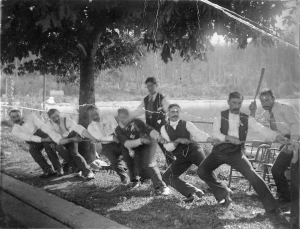Bring on the Conflict and Tension…
Conflict is a vital story ingredient. It’s the thing that keeps readers on the hook, be it fiction or nonfiction. Your protagonist—whether it’s a person, the story of a family, a corporation or a community—has goals. Some of what he or she wanted to achieve got thwarted, and that is where reader interest lies.
“In life, conflict often carries negative connotations,” says Janet Burroway in the Norton guide Writing Fiction, “yet in fiction [and creative nonfiction], be it comic or tragic, dramatic conflict is fundamental because in literature only trouble is interesting.”
Find the Conflict in Your Narrative, and Use It
With this as the vital force for reader engagement, Annette and I urge our students to review their research sources in search of conflict situations. And it’s always there. Maybe your ancestors emigrated from England during the harsh recession of the 1840s, only to find themselves faced with the deep snows of pioneer life in an Ontario winter? There’s the conflict. Their adversaries were poverty and the weather, but it could have been inner turmoil, or a parsimonious colonial government….or all three.
“It is entirely acceptable—in fact, obligatory,” wrote Stephen J. Pyne in his thoughtful book about writing history, Voice & Vision, “to pluck out incidents from the vast welter of experiences and to present them in a way that remains true to the evidence yet allows the intrinsic drama to burst forth.”
How to Build Tension
We’re borrowing tools from the fiction writer’s kit, so let’s take this one step further. If conflict is essential, what’s even more important is tension. Make a chart with the event that precipitated conflict at the top of the page. This is the inciting incident, the moment when the fuse was lit. At the bottom of the page note the crescendo, the moment where the bomb exploded. In between these, list some of the things that happened in the tense moments of buildup. It’s these flashes and mini-explosions, and how your characters responded, that make for great storytelling.
“At the heart of story is tension, and at the heart of tension is unmet desire,” wrote Steven James in an article for Writer’s Digest Magazine in January 2011. “A story isn’t driven forward by events happening, but by tension escalating.”
As James points out, conflict and tension do not require car chase upon car chase. That won’t keep readers enthralled. It’s how your subjects reacted, what they did (or didn’t do) to resolve their problems.
The words conflict and tension can be misleading. It doesn’t have to be high drama. The inner struggles of a character may be enough to captivate. In the case of my book The Quadra Story, A History of Quadra Island, I used the tension between the villages of Quathiaski Cove and Heriot Bay, vying to become the island’s dominant core. It’s subtle, but it adds a contiguous force, a question that intrigues readers and makes them want to read on.

